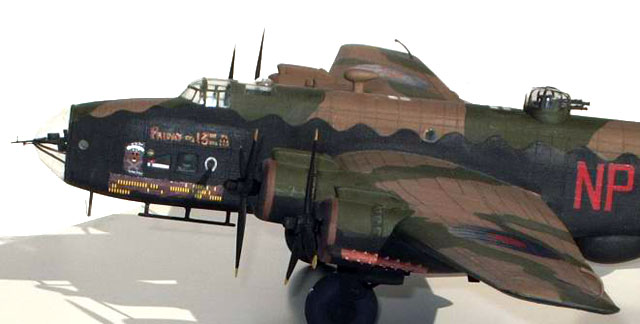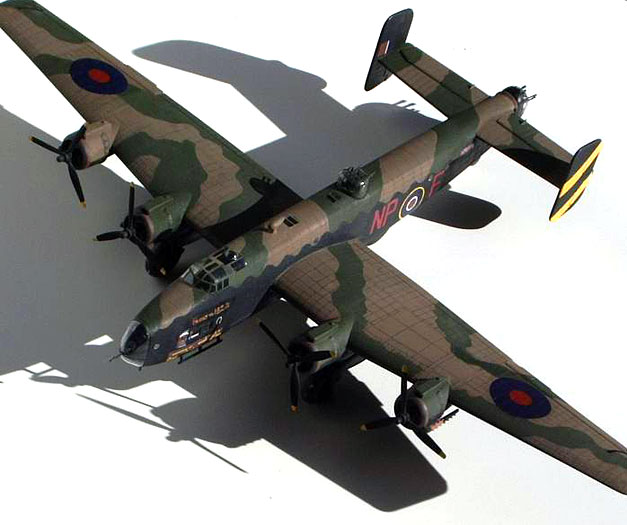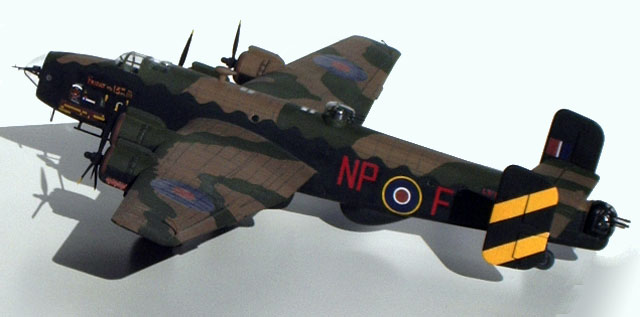|
Airfix's 1/72 scale
Handley Page
Halifax B.III
by
Simon Wolff
|
 |
|
Handley Page
Halifax B. Mk.III
LV 907 Friday the 13th |

Airfix's
1/72 scale Halifax B. Mk.III is available online from Squadron.com
Background
The Handley Page Halifax was the second of Britain’s four engined
bombers to enter service with the RAF in WWII. But the Halifax was the
first RAF four-engined bomber to drop bombs on Germany, in a raid on
Hamburg in March 1941. The Mk.III was the main production variant of the
Halifax and was also the first variant to change from Merlin to Hercules
engines. At peak strength there were twenty-six Halifax squadrons, the
type was also very versatile seeing service in glider towing and
paratrooper operations plus with Special Duty Squadrons.

Sadly the Lancaster tends to get an unfair share of the spotlight out
of four engined Bomber Command types. Certainly ‘Bomber’ (aka Butcher)
Harris in charge of RAF Bomber Command disliked the Halifax, possibly
due to earlier types poorer performance.
Motivation
A few years ago (thanks to a wonderful Canadian mate) I had the good
fortune to visit the RCAF Museum at Trenton
http://www.rcafmuseum.on.ca/reconstructing337.htm and see the
example being restored there. This is NA 337, recovered from a Norwegian
Lake in the 90’s, a later mark that was used for Special Duties. The
dedication to her rebuild is quite amazing and when finished she will be
the only original and complete Halifax on display in the world.
The greatest enjoyment I get out of this hobby is the friendships one
makes, thanks to the friendships, encouragement and assistance of a
number of fellow APMA members (
http://apma.org.au ) I was able to complete this kit. Decals from
one friend (Graham Carter), four propellers from another (Warren Evans),
and the loan of half a dozen reference books (Lindsay Charman, Ley
Reynolds, and Peter Mitchell).
The Model
The Airfix Halifax Mk.III was first released in 1961 and like a lot
of old Airfix kits has really been showing its vintage. It has been
re-released numerous times over the years and I believe is due for
release again this year (with new decals for the first time since
release!).
I obtained a built Airfix Halifax a couple of years ago with a view
to re building the model. Simple and quick or so I naively thought! The
kit was totally paint stripped and major assemblies disassembled (wings
and fuselage). Generally the quality of the mouldings was quite poor
with too many imperfections to list. Initially I added some minor
interior detail such as seat straps and throttle controls.

Then came a long process of deciding what colour to paint the
interior, interior green or black in the end I chose British Interior
Green as the most likely colour, different Halifax’s seem to have had
different interior colours according to who the manufacturer was and
what date.
The clear parts for the kit were not in a good condition and to be quite
honest the turret clear parts are bloody awful (can I say bloody?). A
friend suggested the Squadron Halifax set as alternatives. These were
mostly very useful albeit they are irritatingly niggly to fit!
Especially the tail turret, which is a two-part vacform canopy, fitted
to the kit turret base. In each turret I added some detail, with the use
of the Pavla Defiant (inspired by Graham Green who built the beautiful
Avro Manchester) turret kit parts as reference for the upper turret and
my own photos of the rear turret from the Canadian NA 337. Unfortunately
I found the Squadron nose perspex did not fit!!, however despite the
work involved (in attaching the clear parts) they improve the look of
the model a hundred fold. I also (thanks to another friend’s help)
learnt to plunge mould a new nose perspex!

The remaining kit clears parts were the fuselage windows forward of
the cockpit area, these are over thick and in the end I chose to cut
these back flush with the fuselage halves (which improves the look of
the windows). The hardest part building this kit was fixing the many
gaps along the fuselage joins, round the engine nacelles (large enough
to pass a ham sandwich through) etc these were dreadful and required a
mixture of Milliput and Mr Hobby liquid putty to resolve them. The
fuselage ‘port holes’ needed replacing so a clear plug was inserted in
each and cut back flush then sanded smooth.
All the clear parts were dipped in Johnson Klear, which my brother
kindly (which promptly sat under the kitchen sink for ten years) sent
back from England (UK equivalent of Future) which really improved the
clarity.
The intention was to finish the model as a Canadian example (29,000
operational Halifax missions outs of a total of 37,000 in World War II
were flown by Canadian crews) which I was unable to do. In the end a
friend generously donated a set of decals for the most famous of all
Halifax’s LV907 ‘Friday the 13th’ of 158 Squadron RAF Bomber Command,
which survived the war completing one hundred and twenty eight missions.
She is finished in her last scheme with full compliment of mission
markings. Although an aircraft serving in an RAF squadron her crew
nationality included at times Australians, British, Canadians and New
Zealanders.
For the painting I used a mixture of Humbrol Black and Revell Coal
Black, as I did not feel straight black would look convincing on a scale
model. As for the upper surfaces I used Model Master Dark Green and
Humbrol Matt 29 Brown. One thing I still need to master is a decent
varnish finish and paint that doesn’t attract every bit of fur and
dust!!!!! As I had real problems with the varnishes I applied.

The Airfix Halifax looks like a Halifax however the kit is very dated
(the moulds are looking worn) and I feel Mr Airfix really – really needs
to retire this kit and produce a new example PLEASE!
Click on the thumbnails
below to view larger images:
Model, Images and Text Copyright ©
2005 by Simon Wolff
Page Created 26 August, 2005
Last Updated
25 August, 2005
Back to
HyperScale Main Page
|
Home
| What's New |
Features |
Gallery |
Reviews |
Reference |
Forum |
Search